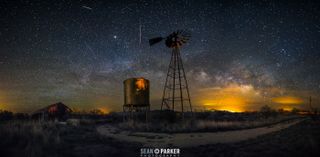
The Lyrid meteor shower will peak overnight tonight (April 22), and you can watch and learn about this annual event during a free webcast from the Slooh Community Observatory.
Slooh's 5-hour-long Lyrids show will feature expert commentary and views from observatories in Chile, the United States, Canada, the United Kingdom and the Canary Islands off the west coast of Africa. You can watch the Lyrids webcast at Slooh.com, beginning at 8 p.m. EDT tonight (0000 GMT on April 23).
"Over the show's 5 hours, viewers will be treated to fascinating facts about meteor showers; learn how they can hear meteors, as well as see them; hear the captivating story of Lyra, the constellation where this shower gets its name; and get a quick lesson in taking their own meteor photographs," Slooh representatives wrote in a media advisory about the webcast, which you can also watch here at Space.com, courtesy of Slooh.
Skywatchers generally see 10 to 20 meteors per hour during the Lyrids' peak, but you shouldn't expect that kind of production this year. The shower's 2016 climax coincides almost exactly with the full moon, whose glare will drown out many of the "shooting stars."
Still, meteor showers are notoriously unpredictable, so it's still worth having a look. You don't need a telescope or binoculars; in fact, such optical tools are more hindrance than help in meteor spotting, since they narrow your field of view considerably.
Simply go outside around or after midnight tonight (the best meteor viewing generally occurs in the pre-dawn hours), lie back and look up, giving your eyes plenty of time to adjust to the dark. Lyrid meteors are caused by debris shed by Comet Thatcher on its sojourns around the sun and appear to emanate from the Lyra constellation. However, they can show up anywhere in the sky, so don't worry about focusing on any particular spot.
Editor's note: If you snap an amazing photo of a meteor, or any other night-sky view, and you'd like to share it with Space.com and our news partners for a story or gallery, you can send images and comments in to managing editor Tariq Malik at spacephotos@space.com.
Get the Space.com Newsletter
Breaking space news, the latest updates on rocket launches, skywatching events and more!
Follow Mike Wall on Twitter @michaeldwall and Google+. Follow us @Spacedotcom, Facebook or Google+. Originally published on Space.com.
Join our Space Forums to keep talking space on the latest missions, night sky and more! And if you have a news tip, correction or comment, let us know at: community@space.com.

Michael Wall is a Senior Space Writer with Space.com and joined the team in 2010. He primarily covers exoplanets, spaceflight and military space, but has been known to dabble in the space art beat. His book about the search for alien life, "Out There," was published on Nov. 13, 2018. Before becoming a science writer, Michael worked as a herpetologist and wildlife biologist. He has a Ph.D. in evolutionary biology from the University of Sydney, Australia, a bachelor's degree from the University of Arizona, and a graduate certificate in science writing from the University of California, Santa Cruz. To find out what his latest project is, you can follow Michael on Twitter.
